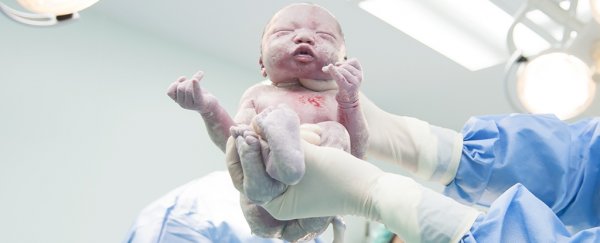Researchers have found new evidence contradicting the idea that babies delivered by a caesarean section don't get the same dose of motherly microflora as those that exit through the birth canal.
Current wisdom assumes that birth plays a vital role in seeding our body with its diverse range of bacteria and fungi, but this discovery fuels the debate on whether the way we leave the womb is really as important for our microbiome as we once thought.
Scientists from the Baylor College of Medicine in Houston, Texas, decided to investigate if previous studies on microbes living on newborns had taken into account the bigger picture of why a baby was delivered via caesarean, or 'C'-section, rather than naturally.
Our body's entire surface (inside and out) is home to between 10 and 100 trillion microbial cells, consisting of as many as 10,000 species - many of which are vital to our existence.
While none of us has the exact same assortment of microbes, we share organisms that fill very similar roles.
They shape our immune system, protect us from pathogens, create vitamins for us, and may even influence our development of metabolic disorders that lead to obesity and diabetes.
As the significance of our body's diverse microbial tenants becomes clearer, researchers' attention has turned to the question of how a clean bunch of embryonic cells inherits a veritable world of germs.
In the early days of obstetrics, it was assumed that the womb was a sterile environment, and infants picked up microbes only as they ate contaminated food.
Today, we know the process of adopting our microscopic citizens begins before we're even born, with microbes being isolated from the amniotic fluid that surrounds healthy pre-born infants, as well as from their membranes, and even umbilical cord blood.
Yet the birthing event itself has been thought to provide the baby with a significant dose of microorganisms – as the baby is born, it comes into contact with a plethora of germs from the mother's vaginal canal, skin, and intestines.
If removed from the womb through an incision, however, it was assumed there was a low chance that the newborn would soak up a decent supply of this microflora.
This has led to practices such as vaginal seeding, where swabs are taken of the mother's vagina and wiped over the mouth, eyes, face, and skin of a baby that has been delivered via C-section.
While the intent seems sound, there's no convincing evidence that this artificial transfer of microbes actually helps give the baby a microbial boost. Not only that, there are concerns that it actually poses an infection risk.
Team member Kjersti Aagaard was aware of the conventional view that babies born via caesarean had a different microbiome.
"However, when we dug into the literature in greater detail, we found that other investigators were not seeing a strong difference in the early microbiomes of caesarean and vaginally delivered infants," she said.
"In fact, the data appeared to be pretty mixed. While some small studies showed a difference, other larger studies did not."
Aagaard and her team sampled the microbiomes of 81 women and their babies in their third trimester through to six weeks after they'd given birth. Another 81 women and their newborns had similar samples taken, but only after delivery.
Samples of microbes were taken from a number of sites, including their gums, stools, nostrils, and genitals.
Whole genome sequencing was used to figure out what kinds of microbes were calling the volunteers' body home.
With the exception of their meconium – the black poo babies are born with – the kinds of microbes covering the newborn's body were all pretty much the same, regardless of whether the sample came from their mouth, nose, or other parts of their skin.
The microbes found in the meconium of newborns delivered by C-section were also identical to those found on newborns delivered vaginally, although the microorganisms found on the skin of both groups was slightly different.
What was a surprise was that by six weeks of age, there was no discernible difference in the microbiomes of the two groups of babies – each had their own, personal microbial 'identity' based on their home and family environment.
This suggests the microbes we get while we're still in the womb could be significantly more important for our development than the method by which we're delivered.
As for previous differences identified in c-delivered infants? Aagard suggests we look to the reasons why the delivery required surgery, and other associated factors such as the use of antibiotics.
A single study with a small sample size can't be the final word on such an important topic as our inheritance of our microbiome. Yet when it comes to the risks and emotions involved with child-birth, it's important we keep a critical eye on the evidence.
This research was published in Nature Medicine.
